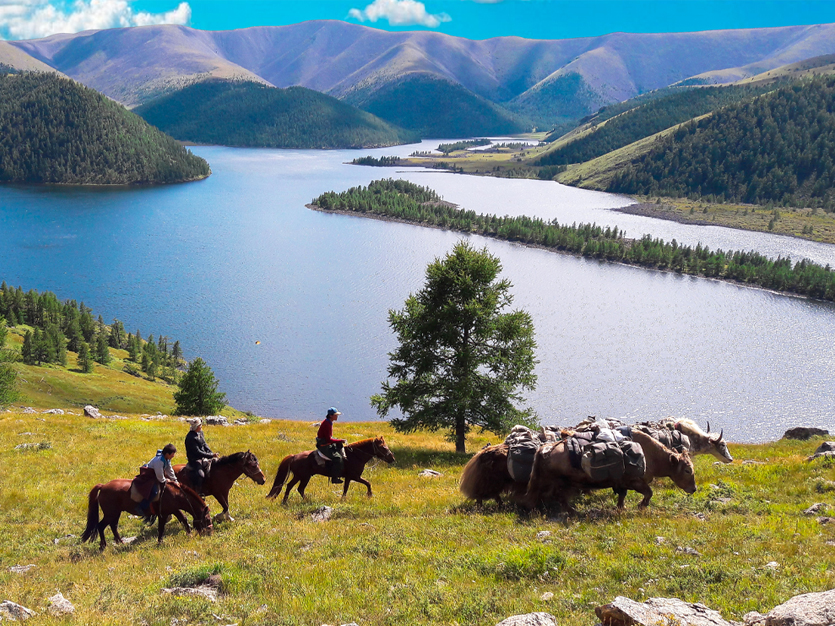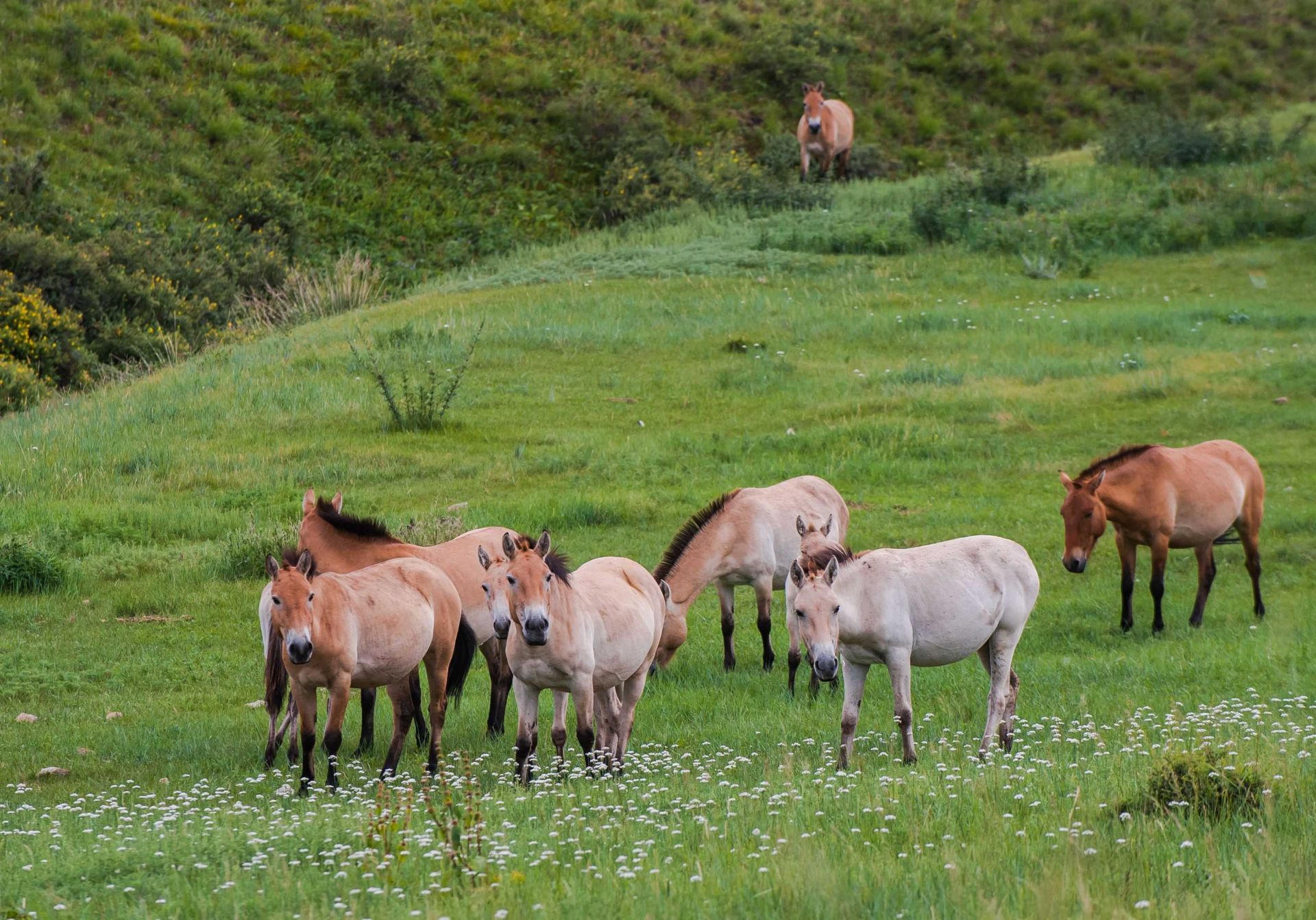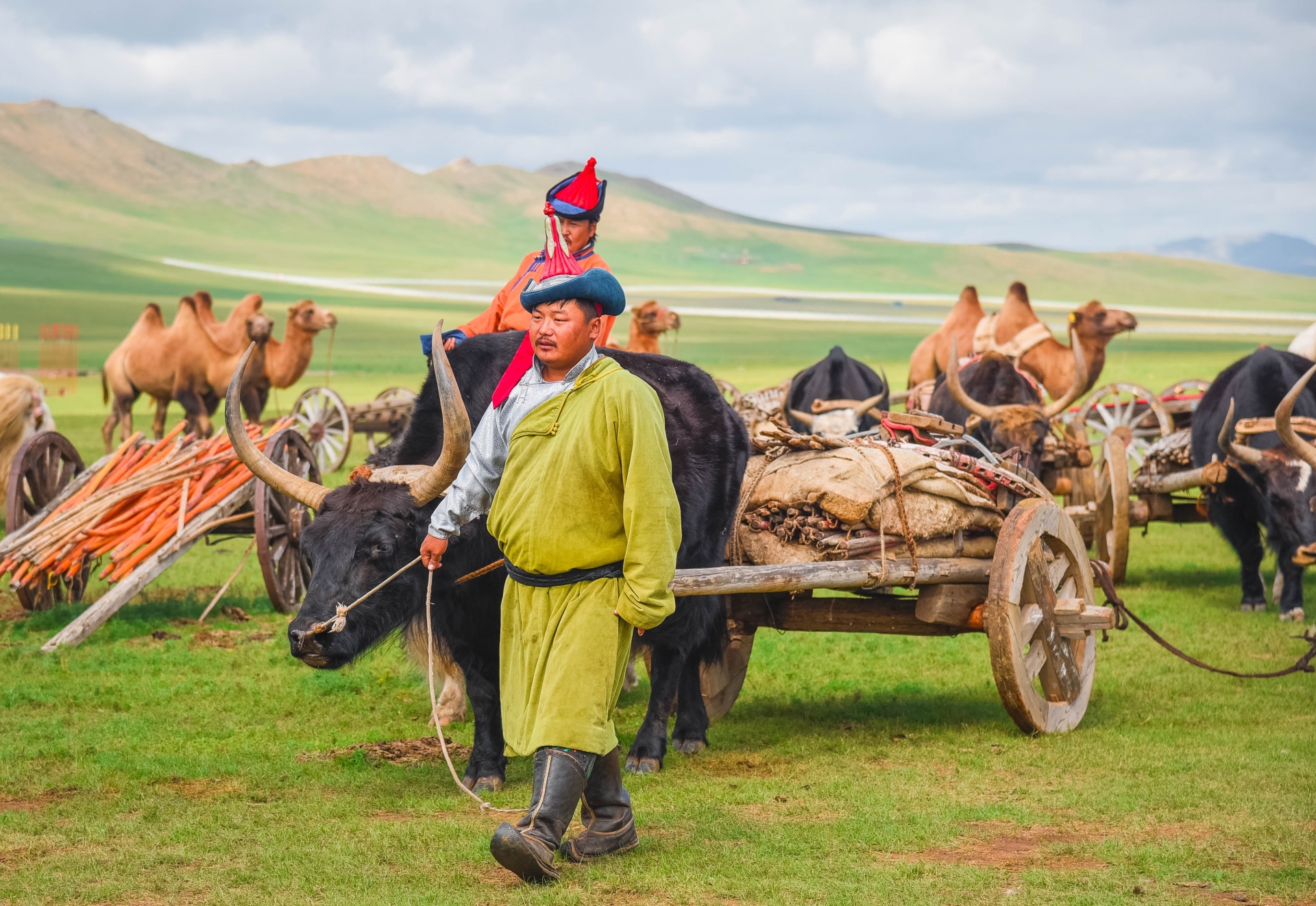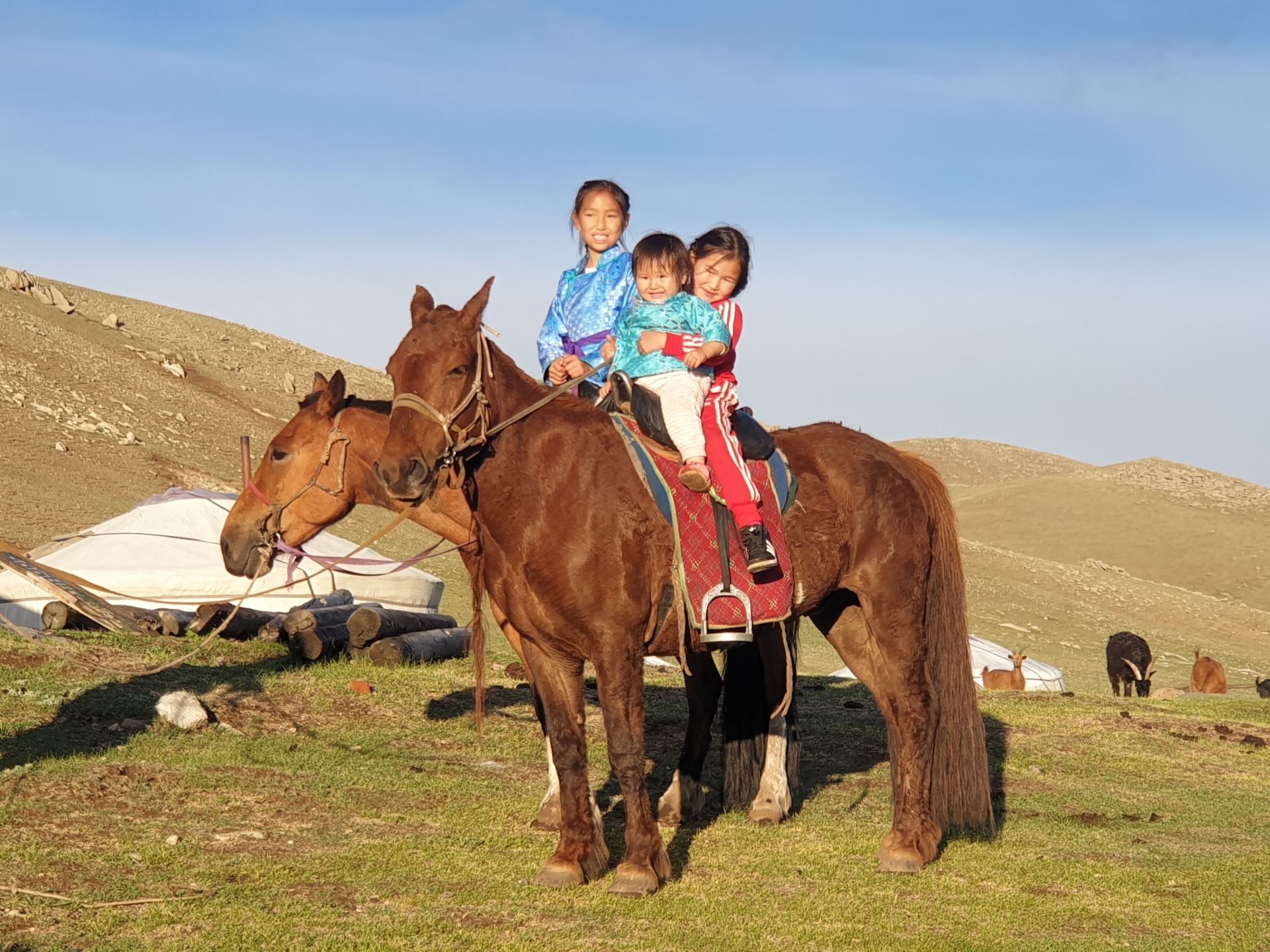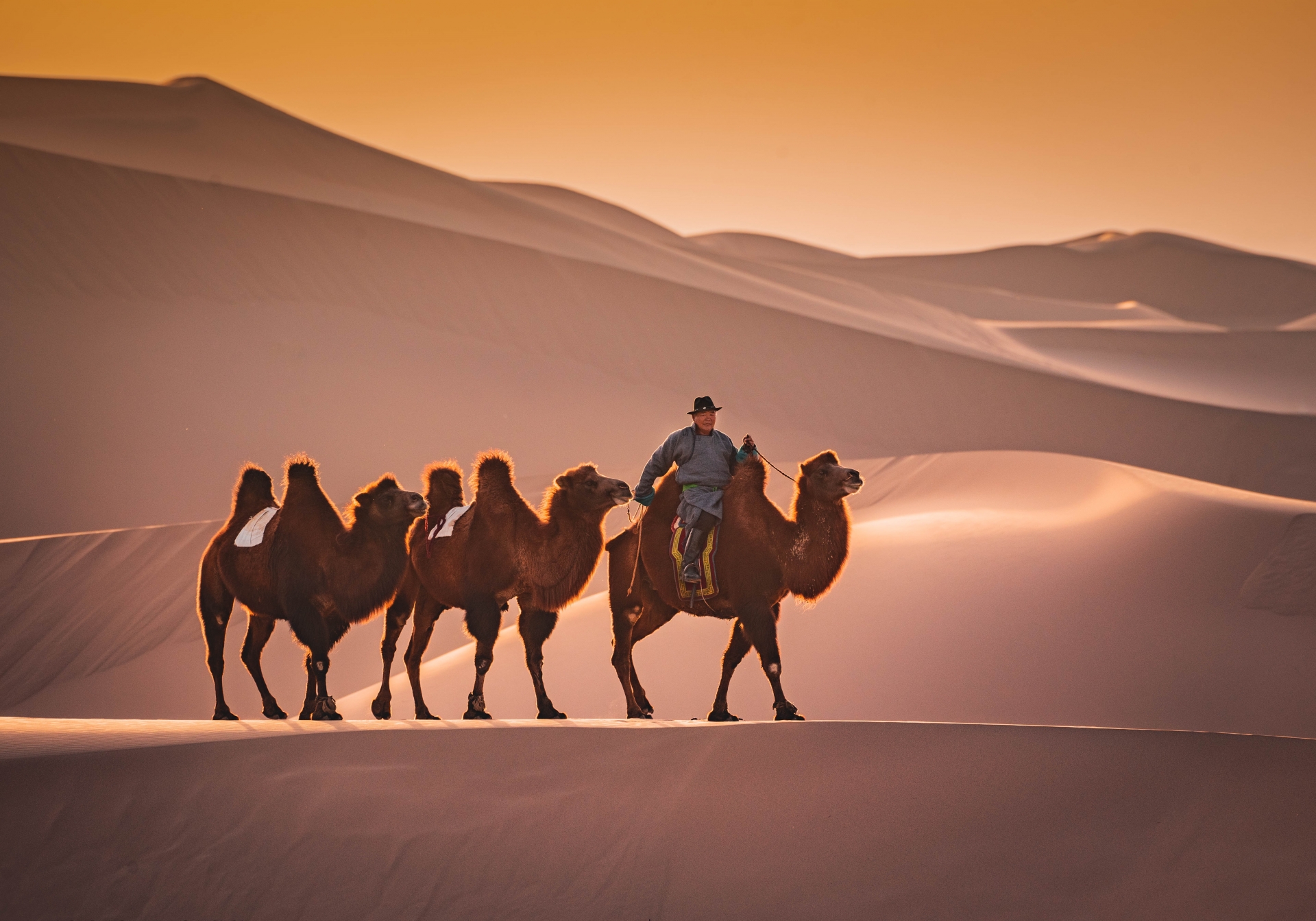Travel with us
Nature Experience in Naiman Nuur / Eight Lakes
Hightlight
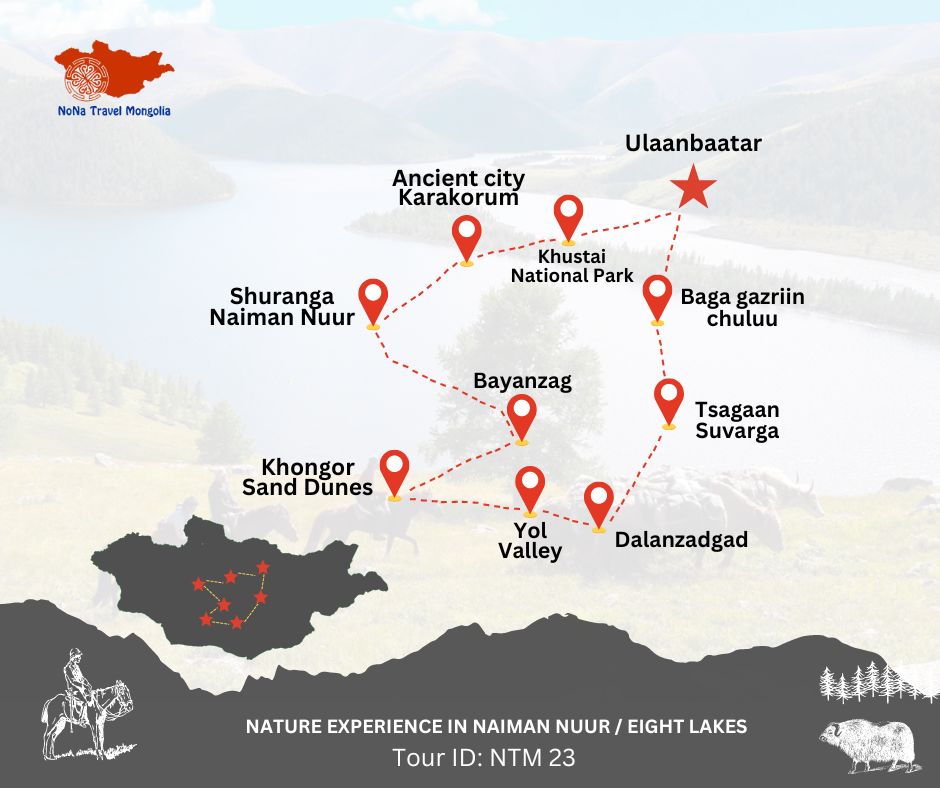
Itinerary
Arrive at Chinggis Khan Airport. Our guide will pick you up with the sign "NoNa Travel Mongolia" and transfer to the hotel (approx. 60 km). Refresh yourself and get some rest. Then we can start sightseeing with the famous Gandan Monastery. The monastery was founded in 1727 and was badly damaged in 1937 during the Stalinist terror in Mongolia, and several buildings were even destroyed. The complex remained closed until 1944, only then was there a conditional re-use of the temples that had been preserved. Until the end of the Mongolian People's Republic, the Gandan Monastery was the only monastery in all of Mongolia in which religious ceremonies - under the control of the secret police - were allowed to take place. But today it has become a peaceful and beloved place for Mongolians. It will always be something special.
After enjoying the first Mongolian meal, visit the newly built Chinggis Khan Museum with rich treasures and go to Sukhbaatar Square, which played a major role in the 1921 People's Revolution. The Government Palace and the statue of Genghis Khan can also be visited here. We are right in the center of the capital city. After walking, we will visit a Mongolian folk art performance with wonderful performances such as throat singing, traditional long song, and contortion. Welcome dinner.
L.D
Today we will drive towards Gobi. Our drive goes to one of the most interesting rock formations in Mongolia called Baga Gazriin. The rocks are scattered in the middle of the grass steppe and the greatest views and valleys open up to us again and again. Very fascinating. Hiking through the rock formations and enjoying beautiful nature.
Today we will drive towards Gobi. Our drive goes to one of the most interesting rock formations in Mongolia called Baga Gazriin. The rocks are scattered in the middle of the grass steppe and the greatest views and valleys open up to us again and again. Very fascinating. Hiking through the rock formations and enjoying beautiful nature.
After breakfast we drive to the next province, Umnogovi (South Gobi). South Gobi has the largest land area of the other 20 provinces. Lunch in Dalanzadgad, the provincial capital. We would see an interesting new museum "Nature and History of the Gobi" which features giant dinosaur skeletons and many other interesting finds from the Gobi. Drive to Yoliin Am (Eagle Valley).
B.L.D
Our journey continues with interesting adventures. Leaving Vulture Gorge and driving through a beautiful mountain gorge if we are lucky we will see wild animals like ibex and wild sheep and we will come across a beautiful gorge following the narrow stream of Gobi river. This is a narrow passage that only a vehicle can pass very carefully. It will be very interesting for you. Believe it
In the early morning watching the beautiful Gobi sunrise’s with its 180 km long sand dunes and the blue mountains behind it will be one of the best things you will ever do in your life. Today we will go to a wonderful place that made Mongolian Gobi known to the world. This is Bayanzag (reach in saxaul), or the place called “Flaming cliffs” because it looks amazingly beautiful like a fire burning in the evening sun. It is important fossil finds have been made. It was given this name by American paleontologist Roy Chapman Andrews, who visited in the 1920s. The area is most famous for yielding the first discovery of dinosaur eggs.
Views to the surrounding desert steppe are wide ranging. There is a small saxaul (haloxylon ammodendron) forest. Although the Saxaul Forest is rather reduced in size now, the local administration has planted new saxaul seeds and they are growing successfully in many areas. It comprises ancient small trees with deep root systems that enable them to survive the desert conditions and is important to protect Gobi from desertification.
B.L.D
Today we will drive to a place connected to the Mongolian religion. We will visit the ruins of the Ongi Monastery on the banks of the Ong River. Built between 1760 and 1810, the monastery had a capacity to accommodate over one thousand monks at one time. It was completely demolished and destroyed in 1939 during anti-religious purges. The foundation of a temple was restored in 2004. Today, the monastery works with a small number of monks. The surrounding scenery is so beautiful that you can go hiking or meditate. We will spend the night in a small hilly area in Middle Gobi province.
After breakfast we are heading to Naiman Nuur eco camp. On the way we will take a look around “Great Horse Shrine '' the complex of horse statues which Mongolian are proud of .
On the way to camp we will see the Red Cliff. It is about 28m high and near Uyanga soum. There some ancient scripts were found from the Red Cliff. Stay at eco camp and meet with family.
Today the horse trip will begin. After breakfast, you will be on horseback to start your trip, meanwhile a horse guide and local staff will assist to put your luggage on yaks’ back and start to move forward to Naiman Nuur /Eight Lakes/. You will stop at the Hill of Shireet which is 3000m high from the sea level for lunch. After that, you will continue to ride Shireet Lake, the first lake of Eight Lakes and stop at the stunning spot for campers to stay in. / for 3-4 hours riding, 15km)
Today the horse trip will begin. After breakfast, you will be on horseback to start your trip, meanwhile a horse guide and local staff will assist to put your luggage on yaks’ back and start to move forward to Naiman Nuur /Eight Lakes/. You will stop at the Hill of Shireet which is 3000m high from the sea level for lunch. After that, you will continue to ride Shireet Lake, the first lake of Eight Lakes and stop at the stunning spot for campers to stay in. / for 3-4 hours riding, 15km)
This day begins with ending the "Khuisiin Naiman Nuur" area and passing the "Bodon" mountain range with views of the natural beauty of the forest, rocky and volcanic origin and lakes and enjoying the lunch at beautiful landscape. Later we visited a herder's family at the "Buurug" valley. / for 4-5 hours riding, 20 km
After breakfast we say goodbye and thank the horsemen and also to the horses and yacks that have transported our luggage.
We drive to Orkhon Waterfall. Orkhon Waterfall, also known as Ulaan Tsutgalan, is one of the top attractions in Central Mongolia. About 25 m downstream from the waterfall you can descend to the bottom of the gorge; 22 m deep and dotted with pine trees. About 20,000 years ago, the waterfall was formed due to earthquakes and merged by volcanic eruptions. However, the water does not run all year round and only starts to flow after the first good summer rain. Walking around and then drive to Karakorum, one of the main tourist attractions in the country. Historically known as Karakorum, it was the ancient capital of the Mongol Empire founded by Chinggis Khan in 1220. And Karakorum was one of the most important cities in the history of the Silk Road. We visit the Karakorum Museum and learn more about the beautiful ancient city of Karakorum and part of Mongolian history.
Visit to the Erdenezuu Monastery, built in the 16th century and housing 108 Buddhist stupas, the oldest and most magnificent.
After breakfast we say goodbye and thank the horsemen and also to the horses and yacks that have transported our luggage.
We drive to Orkhon Waterfall. Orkhon Waterfall, also known as Ulaan Tsutgalan, is one of the top attractions in Central Mongolia. About 25 m downstream from the waterfall you can descend to the bottom of the gorge; 22 m deep and dotted with pine trees. About 20,000 years ago, the waterfall was formed due to earthquakes and merged by volcanic eruptions. However, the water does not run all year round and only starts to flow after the first good summer rain. Walking around and then drive to Karakorum, one of the main tourist attractions in the country. Historically known as Karakorum, it was the ancient capital of the Mongol Empire founded by Chinggis Khan in 1220. And Karakorum was one of the most important cities in the history of the Silk Road. We visit the Karakorum Museum and learn more about the beautiful ancient city of Karakorum and part of Mongolian history.
Visit to the Erdenezuu Monastery, built in the 16th century and housing 108 Buddhist stupas, the oldest and most magnificent.
INCLUSION
INCLUDED
- Std twin room at 4* hotel
- Shared accommodation at Gercamp for 2-4 people
- Private transports
- English or german speaking guide
- All meals as mentioned
- All entrance fee
- Horse ride as mentioned
- Sleeping tents and general camping equipment
NOT INCLUDED
- Personal Expenses
- Optional Activities
- Camera fee
- Travel insurance
- Single supplement
- International Flights
*Pre- and post-program as well as other travel components individually selectable
*Due to the condition of the road network, longer journey times may result
*Program and route are subject to change. The itinerary as sent in the booking confirmation is binding
*If there is no suitable date to join a group for you then create your own group or can book private tour





